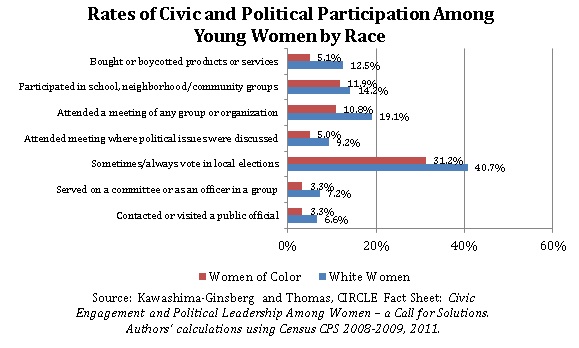New CIRCLE Fact Sheet: Civic Engagement and Political Leadership Among Women – a Call for Solutions
On Monday we posted a summary of comments made by Dr. Kei Kawashima-Ginsberg, CIRCLE’s Lead Researcher, at a White House Conference on Girls’ Leadership and Civic Education. Today we are posting an accompanying fact sheet and a prezi presentation, and in the coming weeks we will present more analysis of electoral participation among young women and men.
The new fact sheet we are posting today summarizes past research and new CIRCLE findings related to civic and political engagement among girls and women. We first identify gaps that explain gender disparities in leadership and then suggest practices that may be especially relevant for promoting political leadership among girls and women. A summary of the fact sheet is in a web presentation (a Prezi) is below.
Our previous post summarized a series of gaps between women, particularly young women, and men. These include gaps in expectations, confidence, and interest. We also note large differences among women of diverse racial and economic backgrounds. These gaps are explained more extensively in this new fact sheet.
For example, the graph below shows an expanding gender gap among college students in confidence in their own leadership skills. Young men are significantly more likely in their senior year to think highly of their own leadership skills, even though young women are more likely to be civically engaged.
Another example from the fact sheet is the graph below, which shows several indicators of civic participation among young White women and young women of color. Young White women are more likely to have participated in every measured indicators of engagement than young women of color. These differences in engagement raise significant concerns about access to opportunities, skill development and encouragement and confidence to take leadership roles.
The fact sheet also suggests implications from the data:
- Strategies to reduce the gender gap in political leadership should begin to reach girls before college age.
- Since young women do participate in community work, they need instrumental support, encouragement, and mentoring to become political leaders who can change laws, policies, or systems to benefit more people.
- More research is needed on women and girls’ civic engagement, such as how girls and boys perceive civics instruction in early grades and whether and how much gender-specific instruction (e.g., learning about female political leaders) and programs (e.g., Girl Scouts) affect girls’ motivation, perceived ability, and desire to pursue careers as elected officials.
- Research and practice should continue to focus on the large race and class disparities among women in both civic engagement and political representation.
An updated web presentation of the research in this fact sheet:
The full analysis can be found here. CIRCLE’s past research looking at gender and its intersections are listed here. Stay tuned for more in the coming weeks.
updated 7/19/2013








May 9th, 2013 at 10:10 am
[…] this page for Kei’s fact sheet and links to other CIRCLE materials. We also propose some strategies for […]
May 16th, 2013 at 9:44 pm
[…] CIRCLE » New CIRCLE Fact Sheet: Civic Engagement and Political Leadership Among Women – a Call fo…. Like this:Like Loading… By gdacc, on May 17, 2013 at 1:25 am, under Voter Participation. Tags: civic engagement, women. No Comments Post a comment or leave a trackback: Trackback URL. « 2013OfficialPoliticalCalendar05072013.pdf […]
February 27th, 2014 at 11:09 am
[…] that these opportunities are not afforded to girls on a regular basis. According to the new fact sheet produced by Civic Youth, in 2008-2011 Women ages 18-29 are more likely to be involved in any type of […]
February 27th, 2014 at 11:31 am
[…] that these opportunities are not afforded to girls on a regular basis. According to the new fact sheet produced by Civic Youth, in 2008-2011 Women ages 18-29 are more likely to be involved in any type […]